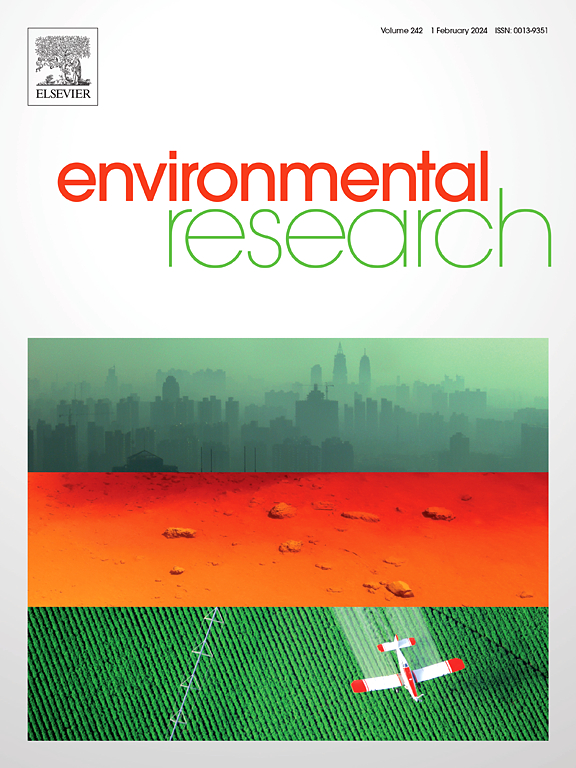“水生亚硒酸盐对斑马鱼幼鱼(Danio rerio)的神经发育和行为影响”的勘误表[环境]。第273(2025)条[121240]
IF 7.7
2区 环境科学与生态学
Q1 ENVIRONMENTAL SCIENCES
引用次数: 0
摘要
硒(Se)是一种必需元素,在高水平的接触下会对鱼类产生剧毒。虽然有机硒对成年鱼的神经行为影响有充分的记录,但无机硒(亚硒酸盐)对神经发育和行为的影响,特别是在生命早期阶段,仍然知之甚少。本研究将斑马鱼胚胎暴露于不同环境相关浓度的水中硒(0(对照)、10、50、100 μg/L;(亚硒酸盐)受精后4小时至30天。我们评估了神经发育和行为结果,以及氧化应激作为亚硒酸盐神经毒性的潜在机制。暴露于高硒浓度(50和100 μg/L)下的幼鱼表现出显著的行为障碍,包括趋近性和反射性运动减少,靠近同种物体的时间明显减少(60%),对新物体的探索性反应降低(1.5倍)。这些行为缺陷与氧化应激升高有关,如DCF-DA荧光强度增加(5.4倍)和关键抗氧化基因失调(0.6-6.4倍变化)所示。此外,亚硒酸盐暴露导致凋亡细胞死亡增加(p <;0.001),与对照组相比,50和100 μg/L硒暴露组的斑马鱼幼虫长度减少了16%,体重减少了33 - 47%。多巴胺能(mao, th1, otpa;所有p <;0.05)和5 -羟色胺能(tph2, pet1, 5ht2c;所有p <;0.05)通路基因,鱼类行为的关键调节因子。总的来说,我们的研究结果表明,亚硒酸盐诱导的氧化应激和神经发育基因失调导致了斑马鱼发育过程中观察到的行为障碍,强调了生命早期硒暴露的潜在风险。本文章由计算机程序翻译,如有差异,请以英文原文为准。
Corrigendum to ‘Neurodevelopmental and behavioural effects of waterborne selenite in larval zebrafish (Danio rerio)’ [Environ. Res. 273 (2025) 121240]
Selenium (Se) is an essential element that becomes highly toxic to fish at elevated exposure levels. Although the neuro-behavioural effects of organic Se are well documented in adult fish, the effects of inorganic Se (selenite) on neurodevelopment and behaviour, particularly in early life stages, remain poorly understood. In this study, zebrafish embryos were exposed to different environmentally relevant concentrations of waterborne Se (0 (control), 10, 50, 100 μg/L; as selenite) from 4 hours post-fertilization to 30 days post-fertilization. We evaluated neurodevelopmental and behavioural outcomes, along with oxidative stress as a potential mechanism of selenite neurotoxicity. Fish larvae exposed to higher Se concentrations (50 and 100 μg/L) exhibited significant behavioural impairments, including reduced thigmotaxis and reflexive movement, spent significantly less time (60 %) near their conspecifics, and lower exploratory response (1.5 fold) to the novel object. These behavioural deficits were associated with elevated oxidative stress, as indicated by increased (5.4 fold) DCF-DA fluorescence intensity and dysregulation (0.6–6.4 fold change) of key antioxidant genes. Additionally, selenite exposure led to increased apoptotic cell death (p < 0.001), and reduced length (16 %) and weight (33–47 %) of zebrafish larvae in 50 and 100 μg/L Se exposure groups compared to the control group. Neurodevelopmental disruptions were evident through altered expression of dopaminergic (mao, th1, otpa; all p < 0.05) and serotonergic (tph2, pet1, 5ht2c; all p < 0.05) pathway genes, critical regulators of behaviour in fishes. Overall, our findings suggest that selenite-induced oxidative stress and neurodevelopmental gene dysregulation contribute to the observed behavioural impairments in developing zebrafish, highlighting the potential risks of Se exposure during early life stages.
求助全文
通过发布文献求助,成功后即可免费获取论文全文。
去求助
来源期刊

Environmental Research
环境科学-公共卫生、环境卫生与职业卫生
CiteScore
12.60
自引率
8.40%
发文量
2480
审稿时长
4.7 months
期刊介绍:
The Environmental Research journal presents a broad range of interdisciplinary research, focused on addressing worldwide environmental concerns and featuring innovative findings. Our publication strives to explore relevant anthropogenic issues across various environmental sectors, showcasing practical applications in real-life settings.
 求助内容:
求助内容: 应助结果提醒方式:
应助结果提醒方式:


